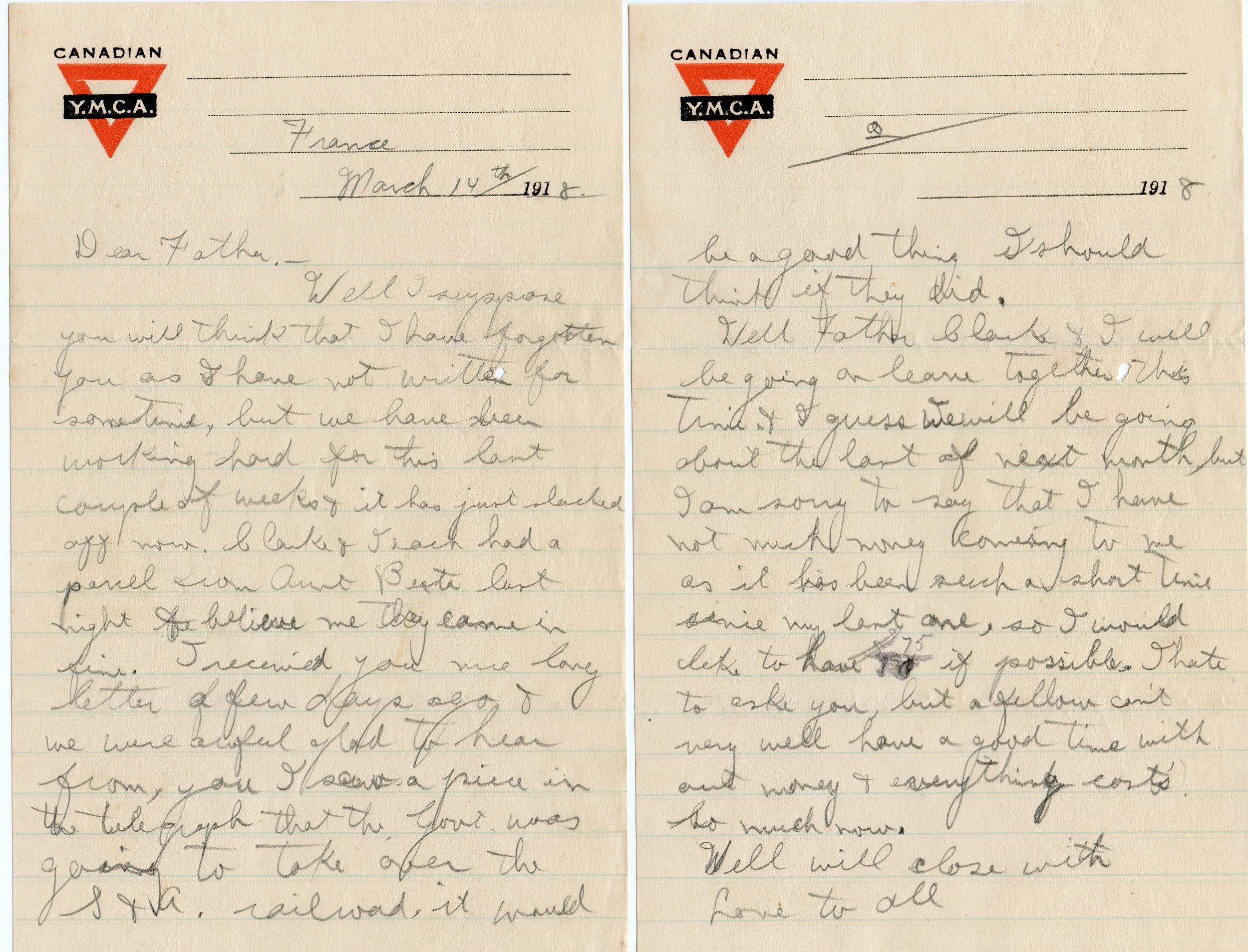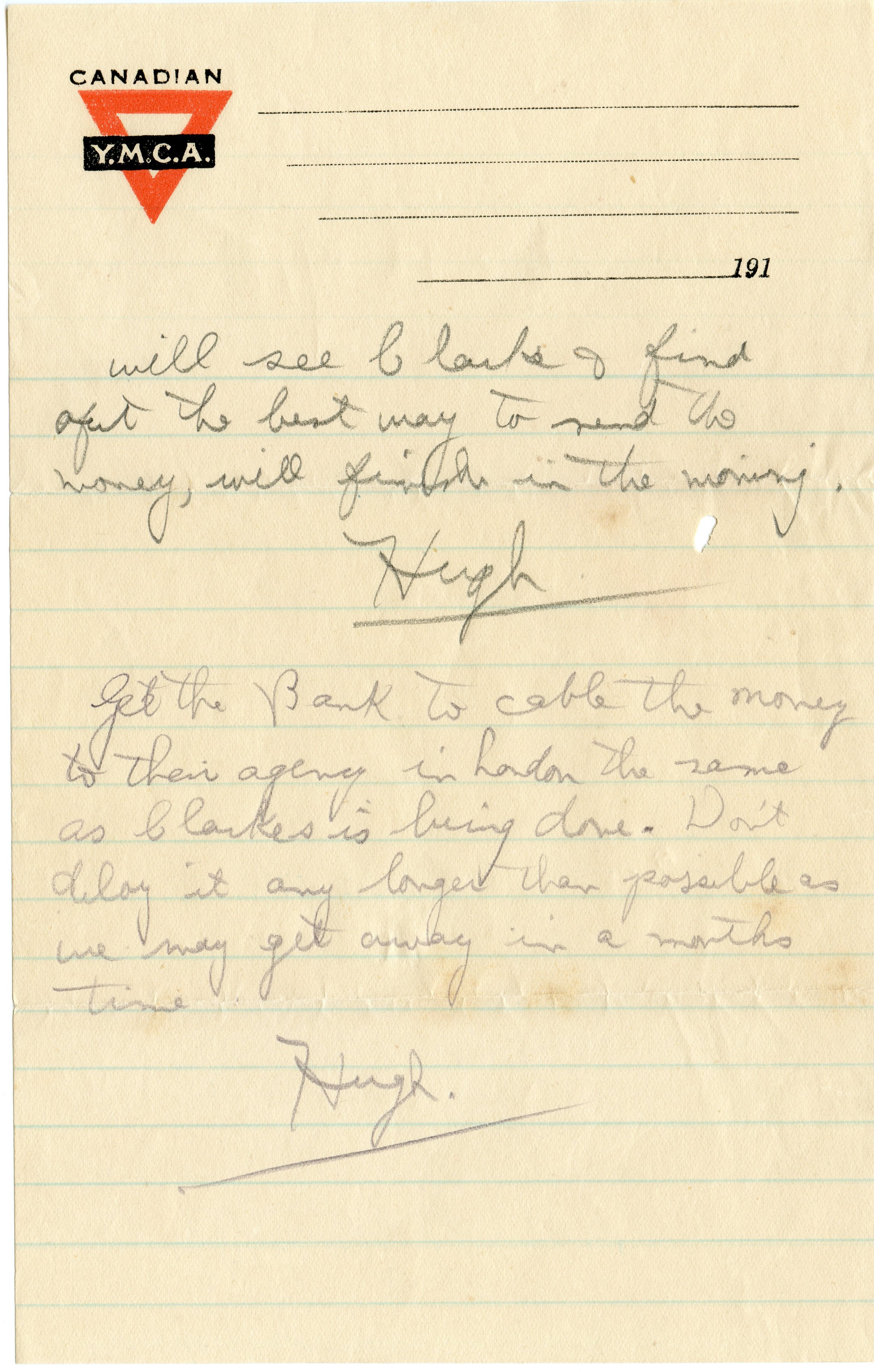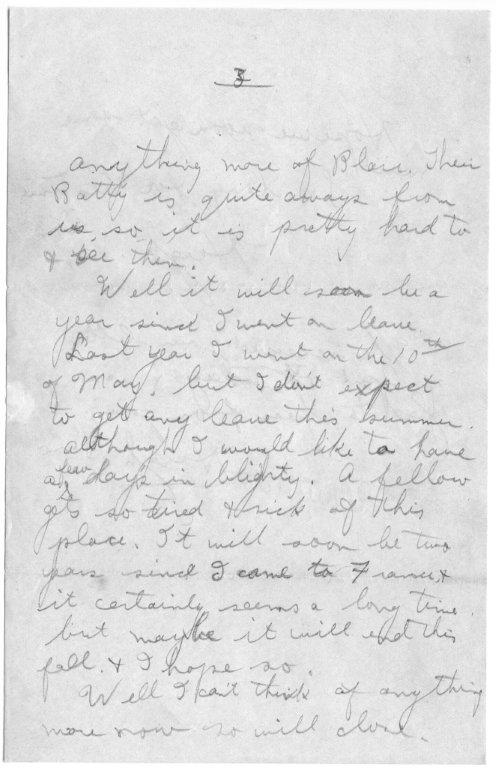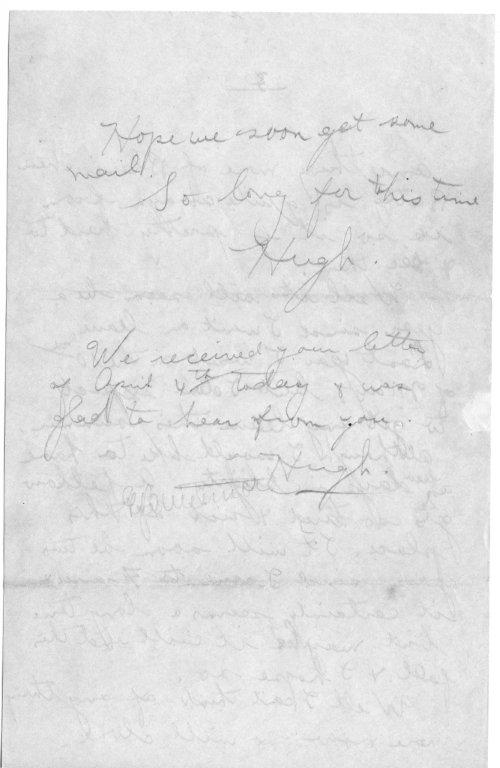“Christmas Cards from First World War soldier, Hugh Wright” - A Great War Tradition
During the years of the First World War (1914 -1918) when the soldiers had to spend Christmas far from home, separated from their families and friends, Christmas cards were important reminders that there was life outside the trenches and outside of the war. Here are a few sent by Hugh Wright. Read more here.
World War I letter written by Albert County soldier, Hugh Wright on November 11, 1918
A Window on the Great War - 100 Years to the Day - A Letter from the Front, March 14, 1918 France
This World War One letter was written by Hugh C. Wright of Shepody (Hopewell) Albert County on March 14, 1918 while he was in serving in the Canadian Garrison Artillery (CGA) in France. Hugh had enlisted in the 26th Battalion on November 17, 1914 when he was 19 years old. He sailed with the 26th Battalion from Saint John on June 13, 1915 aboard the steamship “Caledonia”. They arrived in England on June 24, 1915 where they underwent rigorous training in preparation for going to the battle front.
Hugh served in the 26th Bn, 5th Infantry Brigade in Belgium and France spending 17 months in the trenches. In February 1917, he transferred to the 4th Siege Battery, 2nd Brigade CGA and was a gunner for the remainder of the war. He was discharged on May 10, 1919...on his 24th birthday!
Hugh Wright was the youngest son of James and Jane Wright. Hugh's letters are addressed … “Dear Father” because his mother had died when he was only 7 years old.
Hugh's brother, Clarke Wright, of Hopewell (Shepody) enlisted on October 19, 1915 and went overseas with the C.E.F. Clarke also served in the 4th Siege Battery for the remainder of the war.
“I am very fortunate to have over 50 letters that my Great Uncle Hugh wrote to his family while serving in WWI”. Great Niece Dawne McLean
With many thanks to Hugh Wright's great niece, Dawne McLean who kindly submitted the letter.
"
France
March 14th 1918
Dear Father,
Well, I suppose you will think that I have forgotten you since I have not written for some time, but we have been working hard for this last couple of weeks and it has just slacked off.
Clarke and I had a parcel from Aunt Berta last night and believe me they came in fine.
I received your nice long letter a few days ago and we were awful glad to hear from you.
I saw a piece in the Telegraph that the gov't was going to take over the S & A railroad. It would be a good thing I should think if it did.
Well Father, Clarke and I will be going on leave together this time. I guess we will be going about the last of next month, but I am sorry to say that I have not much money coming to me as it has been such a short time since my last one, so I would like to have $75 if possible. I hate to ask you, but a fellow can't very well have a good time without money and everything costs so much now.
Will see Clarke and find out the best way to send the money,
will finish in the morning.
Well, will close with Love to all
Hugh
Get the Bank to cable the money to their agency in London, the same as Clarke's is being done. Don't delay it any longer than possible as we may get away in a month's time.
**************************
A Window on the Great War - A Letter from the Front, April 29, 1917 France
This World War One letter was written by Hugh C. Wright of Shepody (Hopewell) Albert County on April 29, 1917 while he was in serving in the Canadian Garrison Artillery (CGA) in France. Hugh had enlisted in the 26th Battalion on November 17, 1914 when he was 19 years old. He sailed with the 26th Battalion from Saint John on June 13, 1915 aboard the steamship “Caledonia”. They arrived in England on June 24, 1915 where they underwent rigorous training in preparation for going to the battle front.
Hugh served in the 26th Bn, 5th Infantry Brigade in Belgium and France spending 17 months in the trenches. In February 1917, he transferred to the 4th Siege Battery, 2nd Brigade CGA and was a gunner for the remainder of the war. He was discharged on May 10, 1919...on his 24th birthday!
Hugh Wright was the youngest son of James and Jane Wright. Hugh's letters are addressed … “Dear Father” because his mother had died when he was only 7 years old.
“I am very fortunate to have over 50 letters that my Great Uncle Hugh wrote to his family while serving in WWI”. Great Niece Dawne McLean
With many thanks to Hugh Wright's great niece, Dawne McLean who kindly submitted the letter.
" Somewhere in France
April 29th/17
Dear Father & all ~
Well another week has rolled by & it is my turn to write this Sunday
so here I am trying to scratch off a few lines before dinner.
Well at last the cold weather appears to be about all over & now it
is nice and warm so a fellow can lay out on the grass and enjoy himself
(that is when not working) but a fellow does not mind working when
it is nice and dry underfoot.
I suppose Clarke told you last week about us being up to the Batt and saw
Billie R and Walter D but did not see Joe as he was in the hospital sick and
I am glad that he is, as there has been some pretty tough scrapping going on
here lately and he is better out of it. I have never heard whether Guy R has
ever come to France or not. I suppose Jim is in England yet training.
We haven't had any mail from home for nearly two weeks so it must be delayed
somewhere. I wish you would get me a couple of suits of underwear like I
used to wear when home. The stuff that we get here at the baths is not much,
so I will get my own and do my own washing this summer.
I have not seen or heard anything more of Blair. Their Battery is quite aways
from us so it is pretty hard to see them.
Well, it will soon be a year since I went on leave. Last year I went on the
10th of May, but I don't expect to get any leave this summer although I
would like to have a few days in blighty.
A fellow gets so tired and sick of this place. It will soon be two years since
I came to France & it certainly seems a long time but maybe it will end this fall
and I hope so.
Well I can't think of anything more now so will close.
Hope we soon get some mail.
So long for this time
Hugh
We received your letter of April 4th today and was glad to hear from you.
Hugh
(the signature of the Censor is also written on this last page of the letter)"
The New Brunswick Connection Behind the Captured Vimy Ridge Cannon in Hopewell Cape Just Got Better
The New Brunswick connection to the First World War cannon captured at Vimy Ridge on April 9, 1917 and now found in Hopewell Cape, New Brunswick, just got better. Recent research completed on the German 105 mm K14 cannon, shows that the damage on the barrel of the cannon was probably caused by shells fired by the 4th or 6th New Brunswick Siege Batteries .
The exact location where the K14 was captured on Vimy Ridge is well documented in the war diaries of the 27th Winnipeg Battalion. In fact the diaries give the exact coordinates where the cannon was captured, and when checked against fire mission records for both NB batteries it was discovered that both New Brunswick Batteries fired heavy concentrations of 8 inch high explosive shells on those very German gun positions. Thus it is very possible that the fire that cut the gouge in the barrel was inflicted by New Brunswick's not nearly famous enough Heavy Artillery!
Those NB Siege Batteries were formed in Saint John and included many men from Albert County, including Cyrus Gaskin (d. April 11, 1917). Gaskin is commemorated in the museum's First World War Roll of Honour, and was killed with the 4th Siege Battery not long after Vimy Ridge was captured as the heavies moved forward to help defend it.
The 4th and 6th New Brunswick Siege Batteries are perpetuated by the modern 3rd Field Artillery Regiment (The Loyal Company) in Saint John and Woodstock.
The large German First World War 105 mm K14 Cannon that sits in the square in Hopewell Cape, was captured at Vimy Ridge, April 9, 1917, and won by the Citizens of Albert County during the Victory Loans Campaign of 1919 for raising the greatest percentage of monies over their set goal. The people of Albert County raised $347,000.00 tripling their goal of $110,000.00. That is a pretty impressive resume for a gun.
Now that's a story worth saving!
The Victory Cannon Campaign is raising funds to restore the two captured World War One cannons situated in the square in Hopewell Cape. These cannons were captured by Canadians during the Great War, and were awarded to the people of Albert County. You can donate online to the Victory Cannon Campaign here, and best of all you'll be sent a tax receipt! Click Here to Donate!
“This information was provided to us thanks to a joint research project between The Gregg Centre for the Study of War and Society at the University of New Brunswick and 3rd Field Artillery Regiment, RCA (The Loyal Company). The complete findings of this research project will be published in 2016 as a book tentatively titled “Loyal Gunners: A History of 3rd Field Artillery Regiment (The Loyal Company and New Brunswick’s Artillery, 1893-2012.” Once it is published we’ll do a Blog on it. ”









